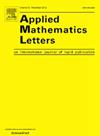[公式略]中热方程的有限时间爆破
IF 2.9
2区 数学
Q1 MATHEMATICS, APPLIED
引用次数: 0
摘要
考虑半线性热方程ut−Δu=|u|p−1u+λu, onrwhere p>1, λ∈R为参数。当λ=0时,方程化为经典热方程。我们发现线性项中的参数λ在爆破条件中起着重要的作用。虽然由于非线性的累积效应,解可能在有限时间内爆炸,但有趣的是,我们发现对于λ>;n2,所有非负解在有限时间内爆炸,这表明Fujita指数等于+∞。我们的结果推广了Quittner and Souplet(2007)中的定理17.1。此外,对于λ<;0,给出了有限时间爆破解的一个新的充分条件。本文章由计算机程序翻译,如有差异,请以英文原文为准。
Finite time blow-up for a heat equation in RN
We consider the semilinear heat equation where , and is a parameter. When , the equation reduces to the classical heat equation. We reveal that the parameter in the linear term plays an important role in the blow-up conditions. Although the solution may blow up in finite time due to the cumulative effect of the nonlinearities, interestingly, we find that for , all non-negative solutions blow up in finite time, which shows that the Fujita exponent is equal to . Our result extends the Theorem 17.1 in Quittner and Souplet (2007). In addition, for , we provide a new sufficient condition for the finite time blow-up solution.
求助全文
通过发布文献求助,成功后即可免费获取论文全文。
去求助
来源期刊

Applied Mathematics Letters
数学-应用数学
CiteScore
7.70
自引率
5.40%
发文量
347
审稿时长
10 days
期刊介绍:
The purpose of Applied Mathematics Letters is to provide a means of rapid publication for important but brief applied mathematical papers. The brief descriptions of any work involving a novel application or utilization of mathematics, or a development in the methodology of applied mathematics is a potential contribution for this journal. This journal''s focus is on applied mathematics topics based on differential equations and linear algebra. Priority will be given to submissions that are likely to appeal to a wide audience.
 求助内容:
求助内容: 应助结果提醒方式:
应助结果提醒方式:


